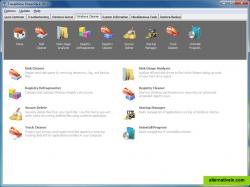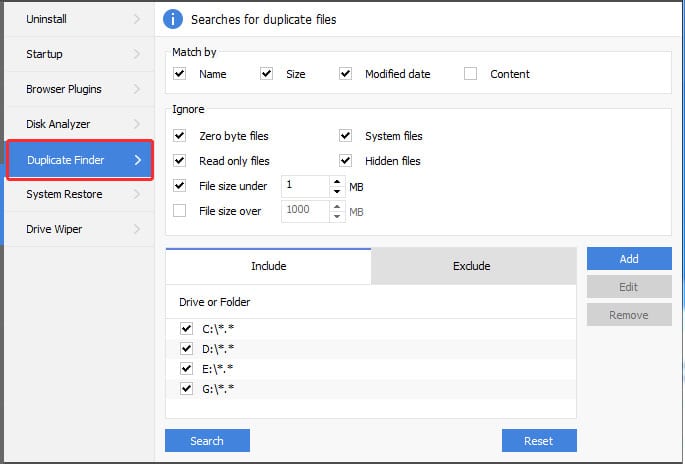

- Ccleaner duplicate finder does not delete files for free#
- Ccleaner duplicate finder does not delete files how to#
- Ccleaner duplicate finder does not delete files drivers#
- Ccleaner duplicate finder does not delete files driver#
- Ccleaner duplicate finder does not delete files for windows 10#
You can upgrade to Windows 7 Ultimate for BitLocker or install VeraCrypt for free encryption. Most of the same tips apply to Windows 7.
Ccleaner duplicate finder does not delete files for windows 10#
if your PC didn’t come with encryption and you don’t want to pay for Windows 10 Pro, you can use VeraCrypt instead. Some Windows 10 PCs already have encryption, while others need Windows 10 Professional to enable BitLocker.
Ccleaner duplicate finder does not delete files how to#
Here’s how to enable full disk encryption on your Windows 10 PC. It will protect any private files you have stored on your computer, too. Anyone who gains access to your computer will need your password to decrypt your hard disk and view your files, so this is a much better method than occasionally deleting your tracks.

If you use CCleaner to delete usage data and “cover your tracks,” here’s a better option: Encrypt your system drive. Encrypt Your Hard Disk to Really Cover Your Tracks You may need to delete folders like this one manually if you’re really tight on space.
Ccleaner duplicate finder does not delete files driver#
Thankfully, NVIDIA told us they now automatically delete older driver versions, so this folder shouldn’t continually grow in size.
Ccleaner duplicate finder does not delete files drivers#
For example, NVIDIA’s graphics drivers use about 1 GB of space on your computer for old driver installers. You may want to perform a web search for the name of the files or the folder they’re in before deleting them-just to confirm you’re not deleting anything important. If they’re temporary, cache, or data files, you can probably just delete them. If the files in question are part of a program, you should uninstall the program from your computer to remove them. If you have some big files hiding somewhere on your computer, you’ll find them with this tool and you can remove them manually. This works like the Disk Analyzer tool in CCleaner, but with a better interface that makes it easier to see what’s using space. This tool scans your hard drive and shows you a graphical representation of what’s using space on your computer, sorting folders and files from the ones using the most space to the least.

To hunt down what’s actually using up space on your computer, install a disk space analyzer like WinDirStat. RELATED: How to Clear Your History in Any Browser Find the Files Wasting Space on Your Computer But, if you want to clear this data anyway, your browser has you covered. Deleting your cache files will slow down your web browsing, too. You’ll have to keep logging into the websites you use every time you open your browser, as their cookies won’t be kept on your PC. We don’t recommend constantly clearing your browsing data or always running in private browsing mode. Browsers now have easy tools that can handle this in a few clicks. To occasionally clear your browsing data, you can use the “Clear Browsing Data” tool built into your web browser of choice. RELATED: How to Always Start Any Browser in Private Browsing Mode This is better than clearing your browsing data in CCleaner, as it prevents that data from being created in the first place. If you never want your browser saving any private data, you can make your browser always start in private browsing mode. Just use private browsing mode whenever you want to access a sensitive website without any history being saved to your computer. In fact, you shouldn’t even need to clear your browsing data in the first place. You don’t need a third-party program to wipe your browser history, cookies, and cache files. On Windows 7, you will need something like MSConfig to manage startup programs. This works the same as the interface in the Settings app, but is also available on Windows 8. You can also launch the Task Manager, click the “Startup” tab, and manage startup programs from here. A startup program with “high impact” slows things down more than one with “low impact.” You can see how much “impact” apps have on your startup process and toggle startup programs on or off from here. To access Windows 10’s startup manager, head to Settings > Apps > Startup. RELATED: 7 Ways To Free Up Hard Disk Space On Windows Manage Startup ProgramsĬCleaner can manage your startup programs, but Windows 10 has this feature built in. The classic desktop Disk Cleanup tool is still included on Windows 10, but the new interface in Settings does the same thing and runs a bit faster. On Windows 7, you can launch the classic “Disk Cleanup” tool from your Start menu to delete these files. RELATED: Use Windows 10's New "Free Up Space" Tool to Clean Up Your Hard Drive Be sure you don’t want to recover any deleted files from your Recycle Bin before checking this option. Warning: If you check “Recycle Bin,” Windows will also empty your Recycle Bin. Check the files you want to delete and click “Remove files” to get rid of them. Windows will automatically scan for files you can delete. To access the Free Up Space tool on Windows 10, head to Settings > System > Storage and click “Free Up Space Now” under Storage Sense.


 0 kommentar(er)
0 kommentar(er)
